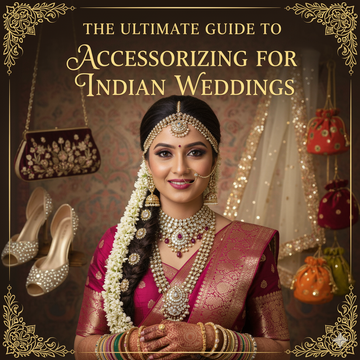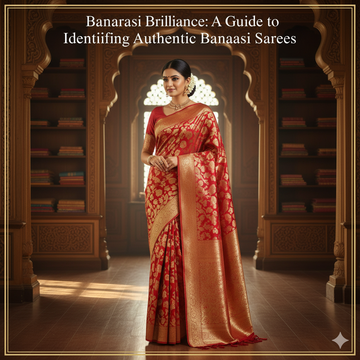Understanding the "Silk Mark": Your Assurance of Pure Silk Quality
by Joelpaes . on Jul 01, 2025

Silk; The Fabric the World Fell in Love With…
Ever since it was first discovered in ancient China around 3000 BC, silk has been one of the most treasured fabrics in the world. Its smooth texture, natural shine, and air of luxury made it a favorite among royalty and traders, and its charm has never really faded. From the days of the Silk Road to today’s fashion houses, silk has stood the test of time.

But have you ever run your fingers across a saree so smooth, it felt like butter, but still wondered if it was truly silk?
In a world flooded with imitations, how can you be sure what you’re buying is the real deal? When you invest in silk, you’re not just buying fabric, you’re buying legacy. But without the Silk Mark, how can you be sure you’re not being duped?
As a nation that stands proudly in the second position of silk production, Silk Mark India is a golden thread of trust and pure silk certification.
The drapes of authentic silk is more than a fabric, it's a feeling. From bridal trousseaus to heirloom sarees, silk holds an irreplaceable place in Indian culture. As demand soars, the market brims with synthetic pretender false reflections that dim the true glow of silk's heritage. In such a world, identifying pure silk isn’t just wise; it’s vital.
In order to navigate the journey of acquiring authentic silk, being aware of silk quality check is essential. Silk Mark is a certification issued by the Silk Mark Organisation of India (SMOI) under the Central Silk Board, Ministry of Textiles. It’s essentially a promise that grants products which are made of 100% pure natural silk, tested and verified through stringent quality checks. It can be considered as a 'BIS hallmark' of the silk world; a seal that speaks of purity, quality, and trust.
Every product bearing the Silk Mark India tag has undergone rigorous testing, be it for fiber content, dyeing processes, or weaving standards. Authorized users, often handloom weavers, designers, and retailers must be certified to use it. This makes it easier for customers to trace the authenticity of the silk from source to shelf.
The value of the Silk Mark India, lies in more than just quality assurance, it’s about ethical consumption and cultural preservation. When you choose pure silk certification, you're not just avoiding fakes; you’re supporting India's vast ecosystem of sericulture farmers, reelers, weavers, and designers. This mark is also especially crucial during high-investment occasions like weddings, festivals, or gifting, where authenticity is paramount. Moreover, the silk quality check ensures durability and longevity. True silk, when properly cared for, can last generations. Without the pure silk certification, it is a gamble on fabric that might lose its luster or integrity after a few washes.
The original Silk Mark India label typically appears as a holographic sticker or tag with a unique identification number. Reputable retailers prominently display it, and many even provide brochures explaining the certification. To ensure authenticity, buy from authorized Silk Mark retailers or ask the seller to show their certification from SMOI. You can also verify certain silk products with burn tests or lab testing, but the Silk Mark remains the easiest and most reliable way of identifying pure silk. In a world where visual similarity can be deceiving, the Silk Mark India with pure silk certification is your safeguard; a small symbol with a big promise.
While the Silk Mark India pure silk certification is the most reliable criterion, there are also a few traditional tricks and tests that you can use to identify pure silk, especially when a label isn’t available.
1. Price; Too Good to Be True? That's not it!
Authentic silk comes at a premium price. It's a labor-intensive, natural fiber that’s been considered a luxury for centuries. So if you find a “pure silk” saree or scarf being sold at a suspiciously low price, chances are it's either mixed with synthetic fibers or completely fake. Trust your gut and your wallet.

2. Appearance; That Shine Definitely Speaks Volumes…
Real silk has a soft, natural sheen that shifts in color under light like a whisper of rainbow on the surface. In contrast, synthetic silk often has a glassy, overly bright shine that looks uniform no matter how you turn it. Also, check the weave; genuine silk usually has minor irregularities that show it was woven by hand or on a traditional loom and not through a mass production machine.
 3.The Ring Test: A Classic Trick
3.The Ring Test: A Classic Trick
One of the oldest ways to test silk is the ring test. Take a silk fabric and try sliding it through a ring. Pure silk; thanks to its fine, soft texture, glides through easily without bunching up. Fake or blended fabrics often resist or get stuck. Just like that, spotted the fake one!
 4. Burn Test & Hand Touch: Handle with Care
4. Burn Test & Hand Touch: Handle with Care
Though not advised or recommended, if you can spare a small thread, the burn test is a reliable method. Real silk burns slowly, smells like burning hair, and leaves a crisp, crumbly ash. Synthetics melt and smell like plastic.
For a safer method, use your sense of touch. Rub the fabric between your fingers or against your hand. Pure silk generates a gentle warmth due to its protein fibers. It should feel soft, smooth, and almost alive under your skin.
Identifying pure silk empowers you to choose quality over imitation, heritage over mass production, and honesty over marketing bluff. In a world where fast fashion thrives on illusion and shortcuts, recognising the truth in what you wear is a quiet act of rebellion and reverence. Pure silk is not just a material; it is a story spun from nature’s finest threads and the skilled hands of artisans who have inherited their craft through generations. Each strand carries whispers of tradition, patience, and pride, elements that simply cannot be replicated by machines or mimicked by synthetics.
Whether you’re shopping for yourself or selecting a gift that carries emotional weight, a bridal saree, a heirloom dupatta, a token of love, knowing how to identify authentic silk becomes a deeply personal responsibility. It means you value not just appearance, but origin. Not just beauty, but truth. It is a conscious choice to honour sustainability, fair labour, and cultural heritage in a marketplace that often forgets the soul behind the shimmer.
Let identifying pure silk be your first step in weaving meaning into your wardrobe. Let it be your quiet standard.
Because true silk doesn’t just adorn the body, it carries a story.





